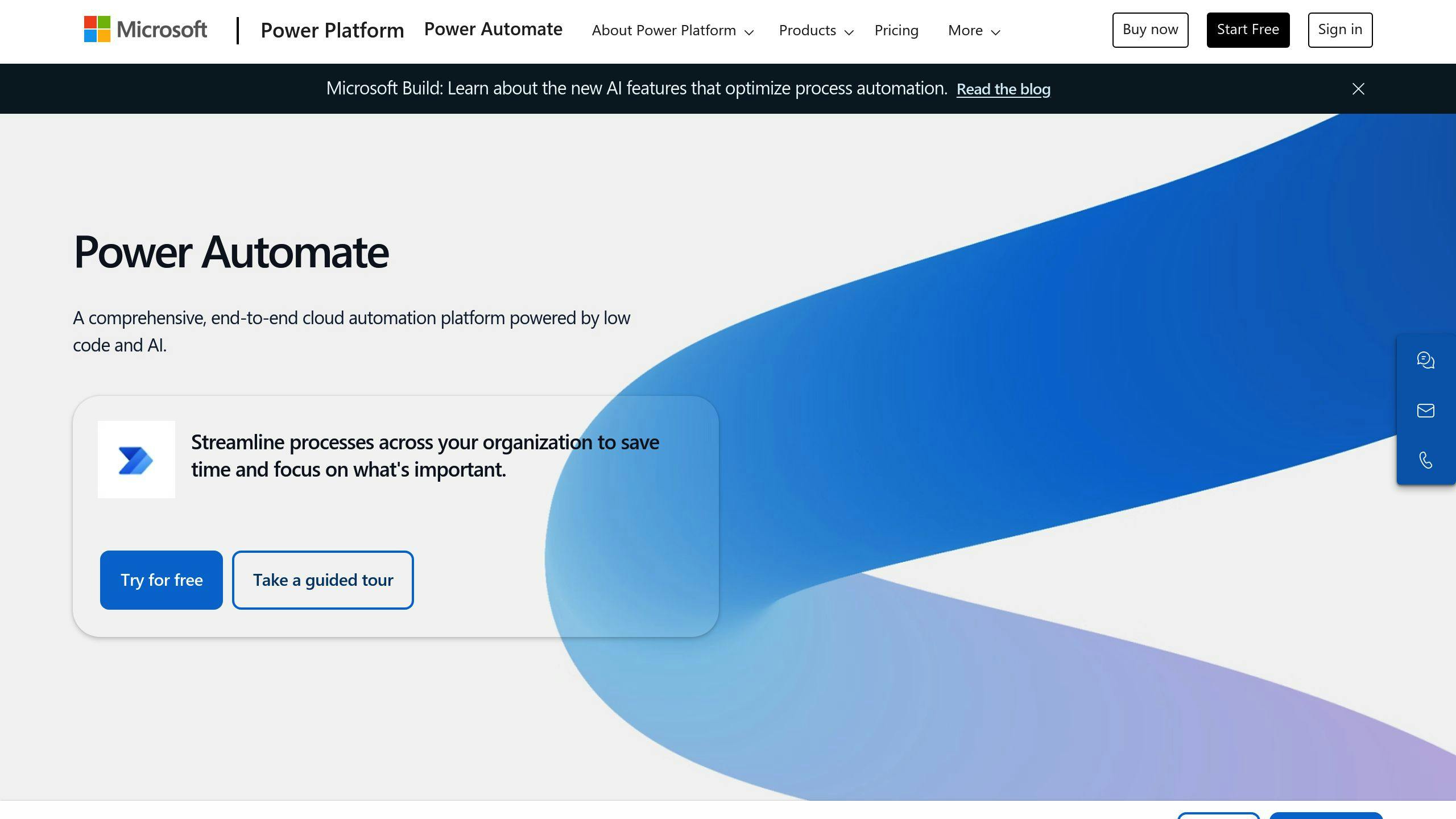Want to save time scheduling meetings? With Power Automate and Microsoft Teams, you can automate the entire process: find free time slots, send invites, and manage details without the hassle. Here’s what you can do:
- Automatically find meeting times that work for everyone, even across time zones.
- Send invites and set up Teams meetings instantly.
- Integrate with tools like SharePoint or Excel to pull attendee lists or meeting details.
- Use third-party tools like nBold for templates and better collaboration.
You’ll need a Microsoft 365 subscription with Power Automate access and the right permissions. Follow the simple steps to set up your workflow, test it, and start saving hours every week.
Related video from YouTube
What You Need to Start Scheduling Meetings with Power Automate

Let’s walk through what you’ll need to set up automated meeting scheduling in Microsoft Teams with Power Automate. Here’s a straightforward guide to get you started.
Microsoft 365 Account and Power Automate Access Requirements
First, let’s check if you have the right tools in place:
Microsoft 365 Subscription Check
- Make sure your subscription includes Power Automate (most business plans do)
- Check your admin portal or ask your IT team about your license
- Verify that Teams integration is active on your account
Most companies using Microsoft 365 Business Standard or Enterprise plans have these features ready to go. Not sure? Your IT admin can help you check.
Permissions and Roles Needed for Workflow Setup
Getting your permissions right is key – without them, you might hit some roadblocks. Here’s what you need:
Basic Requirements
- Power Automate access to create and manage flows
- Teams permissions to schedule and manage meetings
- Access rights to related apps like Outlook or SharePoint if your workflow needs them
Think of permissions like keys to different rooms – you need the right ones to move freely between spaces. For instance, if you’re running cross-department projects, you might need extra access to shared calendars or files. If something’s not working, your IT team can help sort out the access you need.
Optional Tools to Improve Workflow Efficiency
Want to take your workflow to the next level? nBold can help. It works with Teams to:
- Create ready-to-use templates for team collaboration
- Set up and enforce team rules
- Connect with other apps you use
Here’s a real-world example: A marketing team used nBold’s templates for their campaign meetings and cut their setup time by 40%. Plus, it made working across departments much smoother.
Now that you’ve got these basics covered, you’re all set to build your first automated meeting schedule.
How to Set Up a Power Automate Workflow for Teams Meetings
Want to save time scheduling Teams meetings? Here’s a simple guide to creating an automated workflow in Power Automate that does the heavy lifting for you.
Step 1: Start a New Instant Cloud Flow
Head over to office.com and find Power Automate in the waffle menu. Here’s what to do next:
Give your flow a clear name like "Meeting Scheduler". Pick "Manually Trigger a Flow" as your trigger – this lets you test everything before going all-in with automation. Hit "Create" and you’re ready to build.
Step 2: Set Up the Trigger Action
Time to tell your flow when to kick into action. Click the "+" New step" button and search for "Create a Teams meeting". You’ve got options here – maybe you want to connect it to Microsoft Bookings for client meetings, or link it to a SharePoint list that triggers meetings when new projects pop up.
Step 3: Organize Meeting Details
Before creating the actual meeting, let’s get your details in order:
Add a Compose step to handle your meeting info. You can get fancy with timing – schedule meetings for tomorrow using startOfDay(addDays(utcNow(),1)) or plan a month ahead with addDays(utcNow(),30). Plus, you can pull in attendee lists from SharePoint or Excel automatically.
Step 4: Create the Teams Meeting Automatically
Now for the main event – setting up the actual Teams meeting:
Add the Create a Teams meeting action and fill in the details:
- Pull the title from SharePoint or your custom input
- Drop in your agenda and meeting goals
- Set your start and end times
- Add your attendees’ email addresses
Pro tip: A marketing team at Contoso tried this out and cut their scheduling mistakes by 90%. They also got back 2 hours every week – not bad!
Step 5: Send Confirmation Emails to Participants
Last step – let everyone know about the meeting:
Add the Send an email (V2) action and craft your message. Here’s a simple template:
"Hi [Name], your meeting ‘[Meeting Title]’ is scheduled for [Start Time]. Join using this [Meeting Link]."
Before you set it loose, send a test email to make sure everything looks good.
Now you’ve got a smooth, automated system that handles your Teams meeting scheduling like a pro.
sbb-itb-8be0fd2
How to Test and Activate Your Workflow
Let’s make sure your workflow runs smoothly before putting it into action.
Test Your Workflow with Sample Data
Start by running a test with mock data to catch any issues early. Create a test meeting (like "Team Sync Test") and trigger your workflow manually.
Check these key elements:
- Does the meeting show up correctly in Microsoft Teams Calendar?
- Are the title, time, and date exactly as planned?
- Did all test participants get their meeting invites?
- Is the meeting link working?
- Does the agenda appear in the invite?
If something’s off – maybe attendees are missing or the time’s wrong – go back and check your workflow steps. Watch out for date formatting in the Compose step. You might need to tweak formulas like startOfDay(addDays(utcNow(),1)).
Quick Fix: Power Automate’s "Run History" shows you exactly where things went wrong. It’s like having a GPS for your workflow – it’ll point you right to the problem.
Activate and Use the Workflow
Once your tests look good, you’re ready to go live:
First: Hit that save button to lock in all your changes.
Next: Switch your workflow on to start the automation.
Then: Keep an eye on things. System updates can sometimes throw a wrench in the works, so check the Flow Analytics Dashboard regularly to make sure everything’s running as it should.
Want to level up? If you’re using nBold, plug it into your workflow. It helps keep your meeting templates consistent and follows your company’s rules – making the whole process run like clockwork.
Tips for Advanced Features and Troubleshooting
Let’s talk about making your scheduling process work better and fixing common hiccups along the way.
Fix Common Workflow Issues
Running into problems with your workflow? Here’s what to check first:
Test Your Triggers: Before going live, run your workflow with test data. This helps catch any setup issues early – like a missing field or incorrect connection.
Check Your Setup: Make sure you have the right account access (flip back to the "Permissions and Roles" section if needed). Double-check that you’ve filled in all the must-have details for meetings – things like the title, when it starts, and who’s coming.
Smart Scheduling: Power Automate’s "Find meeting times" feature is your friend here. It looks at everyone’s calendars and picks times that work for all. Perfect for those tricky cross-team meetings where finding a good time can feel impossible.
Use Third-Party Tools to Improve Workflows
Want to take your Teams setup to the next level? That’s where nBold comes in. Here’s what it brings to the table:
Meeting Templates That Work: Set up templates for different types of meetings. This way, every sales catch-up or project review follows the same format – no more forgetting the agenda or hunting for files.
Keep Things Secure: nBold helps manage who sees what in Teams. It’s like having a smart security guard who makes sure only the right people can access sensitive stuff, keeping your IT team happy.
Connect Your Tools: Link up with your CRM and other systems. When you’re working on a sales opportunity, nBold can automatically create a Teams meeting and pull in all the relevant info – no copy-pasting needed.
Think of nBold as your workflow’s personal assistant – it keeps things organized, secure, and running smoothly.
Conclusion: Simplify Meeting Scheduling with Power Automate
Setting up automated meeting scheduling in Microsoft Teams with Power Automate makes a real difference in how teams work. Once you’ve tested and turned on your workflow, you’ll see how it takes the hassle out of coordinating meetings. The "Find meeting times" feature makes it simple to schedule across different teams and time zones.
You can shape these workflows to match exactly what your team needs. Whether you’re connecting with SharePoint or other Microsoft tools, Power Automate helps you avoid common problems like double-booked meetings or forgotten details. This matters even more now, with teams spread across home offices and different locations.
nBold takes Power Automate to the next level by adding better control and standardization. It gives you ready-to-use templates and clear rules about who can do what. Teams can work together more smoothly while staying within company guidelines. Plus, nBold makes sure everything stays secure and follows the rules, which is key for any business using automation tools.
